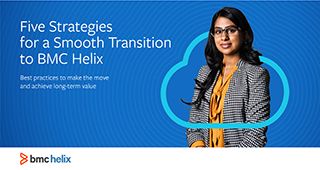There are a number of great reasons for moving to SaaS. One of the most compelling is the significant cost savings over on-premises systems. Industry experts estimate that the SaaS price tag is significantly lower than traditional systems, and given current market volatility and unpredictable business needs, the importance of being conservative with spend has never been greater.
SaaS costs, however, often do prove to be higher than expected. Sometimes this happens because enterprises don’t establish adequate cost control measures upfront. But it could also be due to faster-than-anticipated adoption that delivers additional business value. Consequently, you need to not only control SaaS costs but also accurately assess the business value you realize from your investment. Cost overruns are often offset by increased business value.
This is the first of two blogs examining SaaS cost management. Both consider the context of BMC’s Enterprise 2025 vision, in which every industry will experience seismic changes as people, technologies, data, devices, and an ever-expanding network converge to transform all work and life. By embracing intelligent, tech-enabled systems and championing agility, customer centricity, and actionable insights, your company can evolve to an Autonomous Digital Enterprise, poised to take on today’s challenges as well as those still to come.
This blog presents five pre-implementation practices that can help you avoid missteps as you estimate costs and develop an accurate SaaS budget. The second blog will address post-implementation cost control with a focus on measuring value realized.
1. Minimize the number of SaaS solutions with overlapping functionality
Enterprises are handing over control of technology budgets to lines of business (LOBs) and functional areas such as human resources (HR), finance, marketing, and sales. These groups are opting for SaaS because it’s relatively easy to implement and costs less than on-premises solutions.
Making these purchases within the business delivers real benefits, including unprecedented flexibility in pursuing the initiatives and outcomes that will enhance business success. Unfortunately, it’s not uncommon for enterprises with multiple LOBs to have three or four different solutions for the same purpose, such as service management, marketing automation, or human resources.
Persuading LOBs and functional areas to reach consensus on a single enterprise solution for the same function, or at least to minimize the number of different solutions with overlapping functionality, goes a long way toward containing costs and reducing risk. Here are several talking points to help you influence the business to embrace standards:
- Standardization enables the enterprise to negotiate heftier volume discounts with the SaaS provider. Every LOB and department benefits from more favorable pricing.
- IT staff members develop knowledge and skills around standard solutions. Consequently, they can handle customizations as well as system and data integrations faster and at lower cost. Plus they can provide effective technical support that helps keep employees productive.
- With standards in place, governance and security teams can more readily ensure adherence to the enterprise governance framework and corporate security policies. This reduces the risk of noncompliance with legal mandates and industry standards. Plus, it protects systems and data from unauthorized access. As a result, the enterprise is less likely to be hit with fines and penalties or be the victim of a major security breach that distresses customers and damages the company’s reputation.
2. Look beyond feature set
Businesspeople evaluate SaaS solutions based primarily on each solution’s feature set. But features are only part of the story. To be fully effective, many SaaS solutions require integration with other business systems and data—for example:
- Integrating a service management system with the human resource information system (HRIS) provides information on users.
- Integrating marketing and salesforce automation systems with customer data, inventory, and order entry systems provides richer insight into customer behavior.
LOBs and departments don’t typically have the technical resources to handle the integrations, so the task is delegated to the IT staff. If IT isn’t involved in solution selection, business owners might opt for a solution that doesn’t include out-of-box integrations or application programming interfaces (APIs) that fast track the integration effort. The consequences include higher costs and lengthier implementation time.
In addition, because every business has unique requirements, customization is usually desired. Here, IT should encourage the business to choose a solution that provides an easy, noncoding customization mechanism. The result is that customizations won’t complicate things when it’s time for software updates. It also helps ensure that customizations don’t violate best practices.
Finally, it’s important to encourage LOBs and departments to choose a solution that aligns with the overall technology strategy of the company with respect to standards, governance, and security.
3. Look beyond Day 1
LOBs are often surprised by how quickly SaaS costs exceed budgeted amounts. These overruns often occur because business owners base their SaaS budgets on the expected Day 1 usage and data. However, usage and data volumes can swiftly expand beyond Day 1 levels for a variety of reasons:
- Rapid data growth is common with SaaS solutions and additional data storage capacity adds to your costs. Leave room in your budget for this growth. But also think in terms of not moving all your data—but only the data you need. Use a new SaaS solution as an opportunity to assess your data management strategy and fine tune it—or revamp it entirely—for the SaaS world.
- SaaS solutions open the door to innovation that drives business growth. Innovation often means more users taking advantage of the SaaS solution. Plan for it so you aren’t caught off guard.
- As users adopt the solution, they find new ways to leverage it and they often want to take advantage of capabilities that weren’t purchased for the initial launch. Make sure your budget allows for making these additional capabilities available.
4. Align licensing with expected usage
SaaS pricing structures can be complicated and they vary widely from one SaaS vendor to another. For example, many providers offer tiered licensing based on the level of features used. Some users need access to the full feature set. The majority, however, can often do their jobs with a subset of features. Carefully evaluate your users and determine which features each one needs before you close the deal. That way you won’t pay for functionality that sits idle.
5. Look beyond costs
It’s important to select SaaS solutions that provide tools for tracking costs to enable effective control and optimization of SaaS spend. But it’s also essential to look beyond costs to assess the value delivered by the SaaS solution.
To that end, establish clear business objectives for the SaaS solution and put in place a mechanism for determining if you’re realizing the value expected. (In the second blog of this series, I’ll dig deeper into value realization.)
Lower cost, more innovation
By applying these five practices, you can boost SaaS success by controlling and optimizing your SaaS spend. What’s more, you’ll offload the time-consuming task of managing and maintaining on-premises hardware and software from IT staff—and as your organization considers its evolution to an Automated Digital Enterprise, reimagining the role of IT is paramount. With their time freed up, staff can redirect to business innovation. The result: a sharper competitive edge for your organization and higher job satisfaction and forward-looking productivity for staff.
If you need assistance with your transition to SaaS, please fill out our form and a BMC Customer Success expert will reach out to get started.
Five Strategies for a Smooth Transition to BMC Helix
These postings are my own and do not necessarily represent BMC's position, strategies, or opinion.
See an error or have a suggestion? Please let us know by emailing blogs@bmc.com.







